____________________________________________________________________
Posing
Once in a while a student will ask me this question: "Which of the 12 principles of animation is the most important?" That's one of those questions that's impossible to answer, like "which organ of the body is most important?" You need all of them to live, Silly! But invariably I will try to answer the question, and I start to wonder out loud which principles may be more vital than others. For me it usually comes down to: Posing....Or maybe Timing.
Which one? I think that depends on what you're animating - they type of character, the situation, and the style. For this article I'm just going to focus on posing, and hopefully I can talk about timing more in the future.
Okay, I know that "posing" is not one of The 12 Principles of Animation as handed down on stone tablets by St. Frankenollie, but it's really darn important. It's actually kind of an uber-principle, as it combines elements of other principles within it, such as staging, appeal, exaggeration, and solid drawing. Again, it's a foolish pursuit to try to pick the most important animation principle, and you might rightly offer this counterpoint: posing without timing is just a comic book. Touché! But consider this: still images can suggest motion. And a good animator could animate an entire acting scene within a single clear pose. Live actors hold poses all the time. A good pose can communicate your character's physiology, personality, emotion and intent, even when the scene is paused. Animation is storytelling, and a good pose can tell a story.
The thing that really got me wanting to talk about posing is this photo:

I saw this at an art auction (onboard the Disney Magic, of all places) and it damn near knocked the wind out of me. I had to stop and stare at it for a while to figure out if it was real. I had seen lots of photos of Muhammad Ali, but never this one. Incidentally, I've never been a fan of boxing, nor had I considered it much of a sport until I saw this documentary about Ali. Simply amazing. You must see it.
Anyway, back to the topic. This photo is rad for so many reasons, and it's one of those images that gets me excited about animation all over again. The lines of action are so clear, so extreme in this photo, that it almost feels staged or manipulated. You can feel Ali's lean back onto his right leg, and your brain wants to see the invisible arc of that left hook coming around. Look at the way the other boxer's body leans into Ali with a simple curve, while Ali's main line of action is a strong, straight line. The convergence of these two lines at the boxers' feet creates visual tension, and Ali's supporting right leg makes his silhouette huge and grounded. Check out this article from Carlos Baena for more about lines.
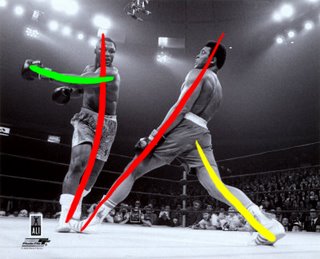 I was so excited about this photo that I had to Google some more. I found this:
I was so excited about this photo that I had to Google some more. I found this: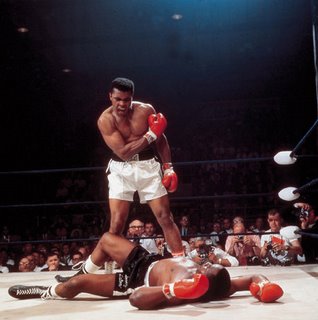 Boom! Another stunning image. There's a slightly more famous version of this photo in which Ali has his right arm at his side, but I like this one better. This image tells a clear story. The composition is so strong, it feels like it could have been a Michelangelo painting. Granted, I'm talking about posing, not staging, but the two are very intertwined, as I mentioned above. Check out all these triangles:
Boom! Another stunning image. There's a slightly more famous version of this photo in which Ali has his right arm at his side, but I like this one better. This image tells a clear story. The composition is so strong, it feels like it could have been a Michelangelo painting. Granted, I'm talking about posing, not staging, but the two are very intertwined, as I mentioned above. Check out all these triangles: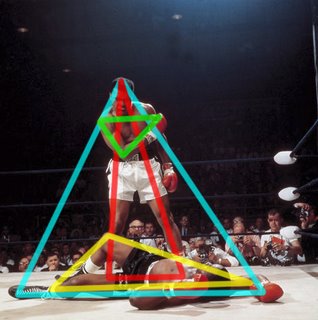
That's some amazing graphical composition! I love how all the triangles are pointed up like pyramids, except for the right arm, which points down at Liston as if to say, "don't even think about getting up!" You can't help but be impressed by Ali's dominance of Sonny Liston, and the posing and composition are reinforcing that story in every way.
Okay, one more Ali picture, just 'cause he's the man:
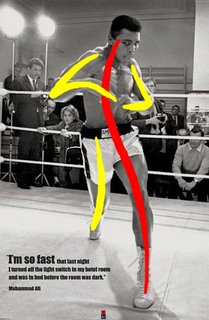
To me, this one is all about rhythm. Visual rhythm, that is. The way that line of action snakes up from his left foot all the way up to his head, the way the right leg echoes and supports that line, and the way the two arms complement the line, drawing your eye to their sharp angles, without ruining the flow of the pose. You can feel the twist of his hips, the lunge forward, the looseness of the wrists. There is a sense of lead and follow, of weight and momentum. You can imagine what came before, and what will come after. Your brain wants to see the action - it's begging for another pose, or at least a breakdown!
Posing is an art form in itself. After all, still poses have been around a LOT longer than animation. For that reason, we have a wealth of imagery and knowledge to draw upon. Look at Michelangelo, Caravaggio, Goya... Hell, look at Rockwell!
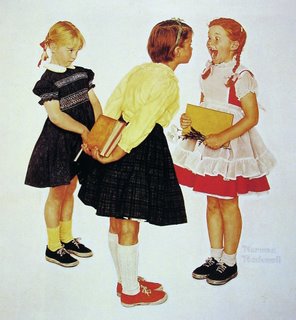
Say what you will about Rockwell's subject matter, but he was a master draftsman and storyteller. You can tell so much about every character in this picture just by the body language. In this case, the way the poses relate to each other is just as important as the poses themselves. As I mentioned, posing is an art from in itself, and has it's own set of principles. Say what?! That's right, if the 12 animation principles weren't enough, here are 28 from master animator and artist, the late Walt Stanchfield:
pose and mood
planes
straights and curves
shape and form
solidity
primary and secondary
anatomy
arcs
action
model or character
squash and stretch
staging and composition
weight
beat and rhythm
anticipation
line and silhouette
depth and volume
caricature
action and reaction
overlap and follow-through
details
perspective
timing
texture
direction
working from extreme
simplification
tension to extreme
positive & negative shapes
Notice that there are a some overlaps with the list of 12. Yes, you can indicate "anticipation" in a still drawing! A few of these are specific to drawing and don't concern the CG animator as much. I'm not going to go into all of these principles here, and I don't purport to have one one-hundredth the talent and experience of Stanchfield, but I think I know what he's talking about, at least. Walt's copious notes on the subject of figure drawing used to be posted over at Animation Meat, but apparently they've been taken down pending their publication of a book. That will definitely be a must-have title! At Pixar we are lucky (I could just end the sentence right here) to have animator and artist Tom Gately, who was a student of Stanchfield, and now instructs his own weekly figure drawing class. While I haven't been exactly regular in attendance (sorry, Tom), I have found that practicing my figure drawing with an emphasis on these principles has improved my drawing and my animation. Not all CG animators draw, but for a lot of us drawing thumbnails is an important part of planning. Knowing how to improve those initial sketches will help clarify your ideas before you get on to the computer. Personally I find that I push my drawings much further than I would be likely to push a CG character, so it's good to start with an extreme drawing rather than the limitations of a computer model.
In closing here's an image that Disney animator Sergio Pablos handed out during a visit to Pixar a few years back, which shows many of the above principles applied. Notice the similarities to the third Muhammad Ali pic, above. I hope Sergio doesn't mind me posting this... Thanks, Sergio!
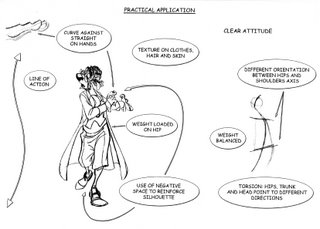
That's all I've got to say for now. There went my Sunday night. Thanks for reading this far!

No comments:
Post a Comment